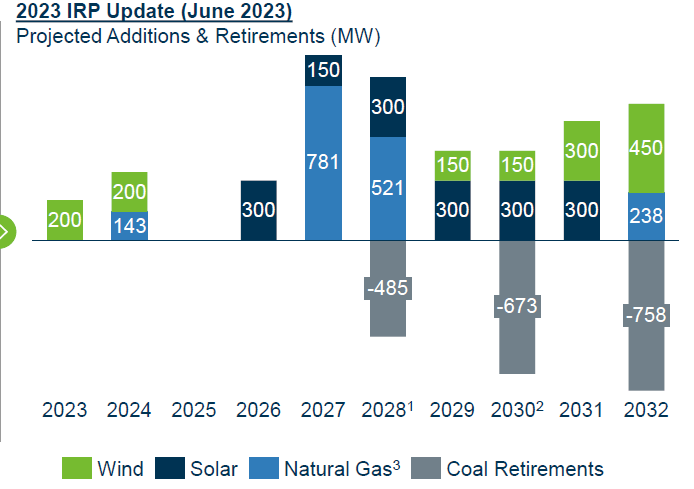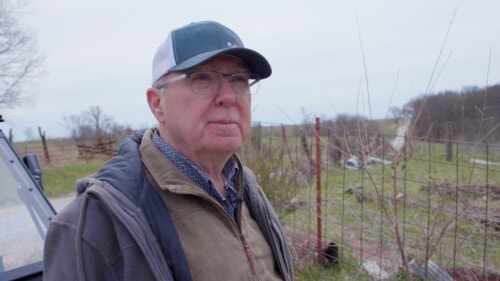Wind Nearly Stopped Blowing Through Midwest Turbines in June Renewable Energy Mystery
Published September 12th, 2023 at 6:00 AM
Above image credit: Chicago-based Invenergy has been developing a 4,000-megawatt transmission line, called Grain Belt Express, expected to carry clean energy generated by wind turbines from Southwest Kansas across Missouri and Illinois, ending at the Indiana border. (Contributed)Technicians monitoring the Midwest’s massive fleet of wind turbines one day in early June rubbed their eyes in disbelief.
In Kansas, wind has become a major source of electricity in recent decades after the erection of 400,000 turbines — about one skyscraping wind generator for every seven residents in the state.
But across a multistate region dubbed the Southwest Power Pool (SPP), energy production from the wind in June nearly stalled completely — a decline of shocking proportions.
Lanny Nickell, executive vice president and chief operating officer of Southwest Power Pool, which manages the grid and wholesale power in the central United States, described the magnitude of the wind generation collapse.
“On June 6 of this year at 10 o’clock in the morning, out of the 32,000 megawatts of nameplate wind capacity, only 110 megawatts of energy were actually produced. That’s less than 0.4% (of capacity). And what’s remarkable about that number is that you would expect across a broad geographic footprint covering all or parts of 14 states that you would see more wind than what we saw.
“That’s an all-time low for us. So that’s been unusual.”

Meteorological Mystery
Is it climate change? What are meteorologists saying?
“We don’t know,” Nickell said. “The jury is still out on that and we’re still trying to figure it out.”
The Southwest Power Pool has already determined that the falloff in wind power production was not caused by grid problems such as not having enough transmission lines or by transmission congestion.
And it was not just a one-day event.

U.S. Energy Information Administration experts who monitor power sector stats reported that both Kansas and Iowa, two of the nation’s top wind generation states, experienced a sharp decline during the entire month of June.
In June, wind production in Kansas amounted to 1,586,965,967 megawatt-hours, down from 2,346,190,645 megawatt-hours in June 2022, a drop of more than 32%, according to Mark Morey, senior advisor on electricity issues for the Energy Information Administration.
Meanwhile, Iowa produced 2,089,640,297 megawatt-hours of electricity in June. That compared to 2,975,520,827 megawatt-hours one year earlier. The decline was almost 30%.
Across America and much of the world, this summer has been characterized by unprecedented heat as climate and weather patterns change, many scientists say, because of still climbing levels of carbon emissions from our industrial society.
Luckily, Kansas, Iowa and much of the region were able to get through June without blackouts, brownouts or power disruptions despite the wind lull.
Determining what exactly happened to the wind, though, is of immense importance to energy planners.
If a shift in climate and weather patterns means that wind generation will be less certain during sizzling summer months when electricity demand is at its highest because of air conditioning load, it would be significant.
Bigger Than Wheat
Folks who drive across the width and breadth of Kansas know that wind turbines have become ubiquitous.
More than $12 billion has been invested in wind generators in the state. They produce $2 billion in retail electricity value a year, which eclipses the economic importance of the state’s wheat crop, according to recent estimates.
The dominant regional private electric utility serving Kansas City and surrounding communities, Evergy, has aggressively developed wind generation in its drive to become a net zero carbon dioxide emitter by 2045.
Currently coal generation, a major contributor to greenhouse gas emissions, still plays an important — though steadily declining — role in Evergy’s ability to satisfy energy demand. Coal this year accounts for 38% of Evergy’s power, according to the utility, while wind generating capacity accounts for 28%.
But to more fully understand the importance of wind to Evergy, consider that its total wind capacity amounts to 42% of its projected peak summer demand this year.
Evergy Leans Into the Wind

Turbines Dot Kansas
Meanwhile, in sparsely populated counties across Kansas, the continued growth of wind power is becoming increasingly polarizing.
Some consider the wind turbine towers or their lights unsightly, while others claim they have legitimate concerns about the health impact of the units. Others want the wind generators to help boost their local economy, provide clean energy and maintain an attractive way of life far from urban centers.
Laurie Schmelzle in Seneca, Kansas, about 75 miles north of Topeka, supports wind energy and says those citing health concerns employ “bogus arguments.”
“We are in a rural area with declining population and few new opportunities for economic advancement,” she said, adding that she and her husband, Martin, a native of Seneca, “have no financial interest in wind… and we definitely support renewable energy.”
The fight over wind has turned ugly, she said, with opponents taking over city and county elected positions and trying to use their political power to ban wind developments.
Recently, Schmelzle turned to a former farmer and internationally renowned developer of sustainable, non-carbon emitting communities in Denmark for lessons on how to frame the debate over the future of energy, so it is less politically divisive.
“I’m trying to look for some ways to bring the county together,” she said.
Pondering Wind Power
Back at Southwest Power Pool headquarters in Little Rock, Arkansas, the concern is more technical.
The power pool has determined that when wind generation crashed in June, the cause was not congestion on transmission lines.
“There was just much less wind available, not that available wind couldn’t be dispatched,” said SPP spokesperson Derek Wingfield.
Energy power planners closely watch the “reserve margin” of power that they have to meet soaring demand caused by weather, power failures or other calamities that could quickly become deadly.
“If that same wind pattern had occurred during a peak demand day, that would have been a bad, bad situation… It was stressed, absolutely. We’re just seeing some all-time lows that we haven’t seen previously.”
Lanny Nickell, executive vice president and chief operating officer of Southwest Power Pool
“If that same wind pattern had occurred during a peak demand day, that would have been a bad, bad situation,” Nickell told the U.S. Department of Energy “Grid Talk” podcast.
SPP is worried that regional reserves were not what they should have been.
“We had about 2,000 megawatts of what we characterize as headroom. That’s close because that means you can have a couple of contingencies and the headroom goes to zero,” Nickell said.
Power reserves were at a scant 5%, one-third of what planners hope to have.
“It was stressed, absolutely,” Nickell said. “We’re just seeing some all-time lows that we haven’t seen previously.”
Martin Rosenberg is a Kansas City journalist and host of the Grid Talk podcast on the future of energy.



